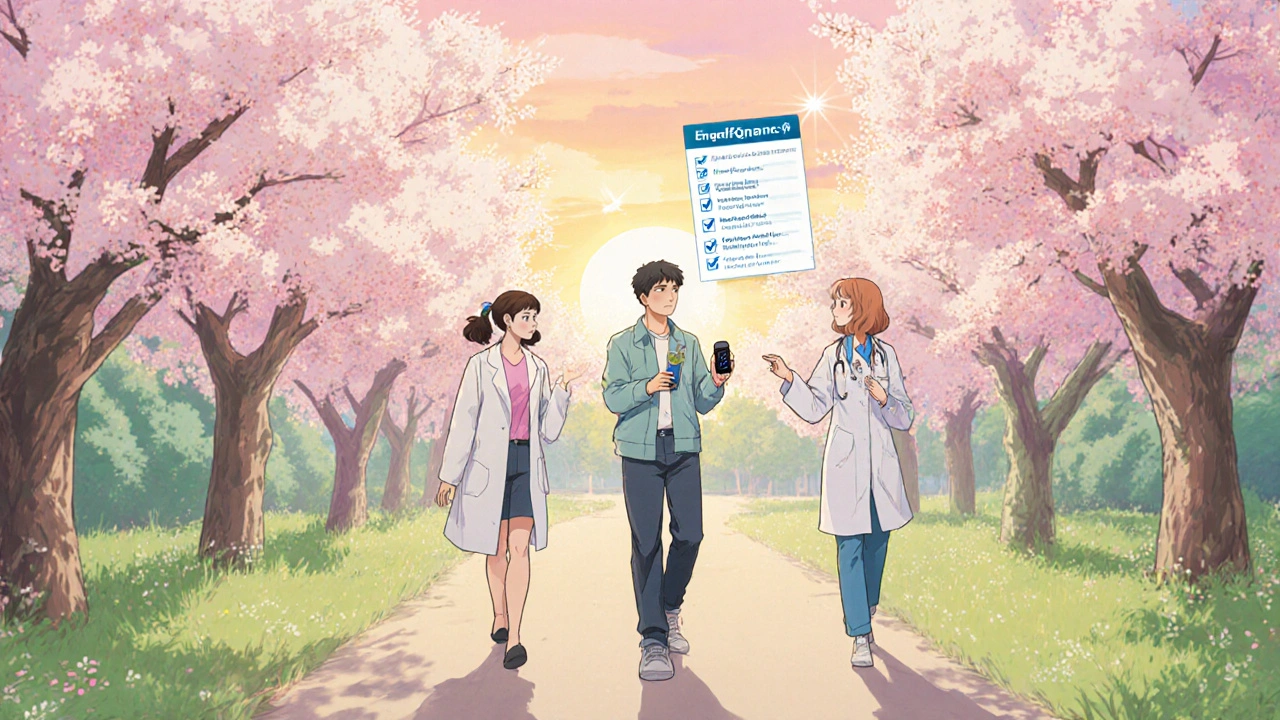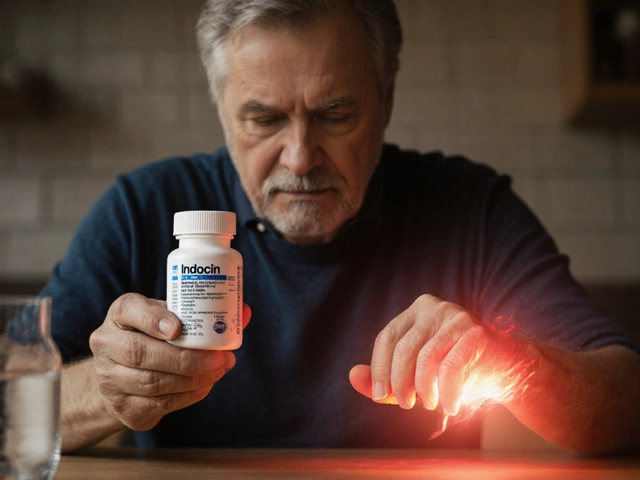SGLT2 Inhibitor Eye Safety Comparison Tool
Select an SGLT2 inhibitor to see the most relevant eye safety information based on clinical data.
Select an SGLT2 inhibitor to view its eye safety profile.
When a prescription for a diabetes drug lands on your kitchen table, the last thing you think about is your eyesight. Yet mounting evidence shows that the popular SGLT2 inhibitor Canagliflozin is a blood‑sugar‑lowering medication that works by making kidneys flush excess glucose in the urine. If you’re taking it, you’ll want to know how it could affect your eyes and what steps keep your vision sharp.
What Is Canagliflozin?
Canagliflozin belongs to a newer class of drugs called SGLT2 inhibitors which block the sodium‑glucose co‑transporter‑2 protein in the kidney’s tubules, reducing glucose re‑absorption and boosting its excretion. It’s sold under brand names such as Invokana and is approved for type 2 diabetes, chronic kidney disease, and heart failure.
How Canagliflozin Works in the Body
By forcing kidneys to dump extra glucose, the drug lowers blood glucose levels without stimulating insulin. This mechanism also leads to modest weight loss and lower blood pressure, benefits many patients appreciate.
Common Side Effects You May Already Know
Most users experience mild issues: urinary tract infections, increased urination, and occasional genital yeast infections. These are well‑documented in the drug’s label and often managed with simple hygiene tweaks.

Eye‑Related Concerns: What the Data Show
Vision problems weren’t on the original safety radar, but post‑marketing reports and a handful of clinical studies have raised eyebrows.
- Diabetic retinopathy: Some trials noted a slight uptick in progression of existing retinopathy when patients dropped their A1C quickly.
- Glaucoma: Case reports describe transient intra‑ocular pressure spikes, especially in people with a family history of glaucoma.
- Cataract: A few observational studies suggested a marginal increase in cataract surgery rates, though causality is unclear.
- Macular edema: Rare swelling of the central retina has been reported, usually resolving after stopping the medication.
Regulatory bodies have taken note. In 2023, the FDA issued a safety communication highlighting the need for eye exams when rapid glucose control is achieved. The UK’s National Health Service (NHS) recommends baseline retinal screening for all patients starting SGLT2 inhibitors.
Comparing Ocular Risks Across SGLT2 Inhibitors
| Drug | Ocular events noted | Frequency (per 10,000 users) | Key notes |
|---|---|---|---|
| Canagliflozin | Retinopathy progression, glaucoma spikes, macular edema | 3‑5 | Risk higher when A1C drops >2% quickly |
| Dapagliflozin | Minor reports of cataract, dry eye | 1‑2 | Data limited, mostly anecdotal |
| Empagliflozin | Retinopathy stabilization in some trials | 0‑1 | Shows possible protective effect |

Practical Tips for Protecting Your Vision
- Schedule a comprehensive eye exam before starting canagliflozin. Document any existing retinal changes.
- If your A1C is expected to fall sharply, ask your doctor about a slower titration schedule.
- Report any new visual disturbances-blurred spots, flashing lights, or sudden eye pain-to your clinician immediately.
- Maintain good blood‑pressure control; high pressure can exacerbate glaucoma risk.
- Stay hydrated, but avoid excessive fluid intake that could trigger eye pressure fluctuations.
Talking to Your Healthcare Provider
When you discuss canagliflozin with your doctor, bring up the following points:
- History of diabetic retinopathy, glaucoma, or cataract surgery.
- Current eye‑care regimen and any recent ophthalmology visits.
- Other medications that might affect eye pressure, such as steroids.
- Whether a baseline retinal scan or OCT (optical coherence tomography) is advisable.
Most clinicians will adjust the dosage or schedule additional eye‑checks if they see red flags. Collaboration between your endocrinologist, primary‑care doctor, and ophthalmologist is the safest route.
Frequently Asked Questions
Can canagliflozin cause permanent vision loss?
Permanent loss is rare. Most eye‑related events are reversible if caught early and the drug is paused. Ongoing monitoring is key.
Do I need an eye exam every time my dose changes?
If the dose increase is modest, a routine annual exam usually suffices. Large jumps in dosage merit an extra check within 3‑6 months.
Are other SGLT2 inhibitors safer for the eyes?
Evidence is mixed. Empagliflozin shows fewer reported ocular events, while dapagliflozin has limited data. Choose the drug that best matches your overall health profile.
What symptoms should prompt an immediate doctor visit?
Sudden blurry vision, flashes of light, eye pain, or a rapid increase in floaters could signal retinal problems or pressure spikes. Call your eye doctor or go to urgent care right away.
Can lifestyle changes reduce eye‑related risks while on canagliflozin?
Yes. Keeping blood sugar, blood pressure, and cholesterol in target ranges, exercising regularly, and avoiding smoking all support retinal health.








They say a sugar‑lowering pill is harmless, yet the silent eyes of the pharma giants whisper otherwise.
Every drop of glucose excreted carries a hidden cost, a trade‑off the boardrooms conveniently ignore.
When the FDA nudges us toward eye exams, I wonder who's really steering the narrative.
I hear your doubts, and they’re not unfounded; the data does suggest a correlation between rapid A1C drops and retinal strain.
Still, we shouldn’t throw the drug out the window – a measured titration can keep both sugar and sight in check.
Talk to your endocrinologist about a slower ramp‑up; your eyes will thank you.
Ah, the usual pop‑science summary that glosses over the covert trials funded by the very manufacturers advertising Invokana. 🙄
While the mainstream narrative paints Canagliflozin as a benign ally in the fight against diabetes, I contend that the ocular side‑effects are deliberately downplayed to preserve market share.
Consider the timing of the FDA’s safety communiqué – coinciding with a surge in the drug’s sales, almost as if the regulator were a reluctant partner in a grand pharmaco‑political scheme.
Patients of North American descent are especially targeted, their healthcare systems eager to adopt the newest 'miracle' without scrutinizing long‑term retinal outcomes.
Moreover, the comparative data showing Empagliflozin’s potential protective effect is conveniently buried beneath layers of corporate press releases.
We, as informed citizens, must demand transparent, independent ophthalmologic trials before embracing any SGLT2 inhibitor wholesale.
Otherwise we simply trade one set of health issues for another, and history will repeat its familiar pattern of profit over patient safety.
Yo, I was just kicking back reading about Canagliflozin and thought, ‘cool, another pill that makes my kidneys work overtime’ – but then the eye‑risk list hit me like a plot twist in a sci‑fi flick
The whole thing feels like a carnival ride, bright lights and all, but you never see the depth of the tunnel until it’s too late
Your observations are spot‑on; maintaining regular ophthalmologic assessments while initiating therapy is a prudent strategy.
It is advisable to coordinate care among your endocrinologist, primary physician, and ophthalmologist to ensure any ocular changes are identified promptly.
I commend your proactive approach to patient education.
We often chase the numbers on our glucometers, but what truly matters is the clarity with which we see the world around us.
If a medication promises to tame glucose but threatens to blur our vision, the cost‑benefit equation must be re‑examined with a holistic lens.
Behold! The saga of Canagliflozin is not merely a pharmacologic footnote; it is a moral crucible demanding our unwavering scrutiny!!!
To swallow this pill without demanding comprehensive eye exams is to betray the very essence of responsible stewardship over our bodies!!!
Quick tip: schedule an eye check before you start the medication.
Good call that’s an easy step and it could save a lot of hassle later
Starting a new medication like canagliflozin is a brave step toward better health.
Your body is a partnership of many systems that deserve respect.
When you add a drug that changes how kidneys filter sugar you also invite changes in the eyes.
Research shows a link between rapid drops in A1C and retinal stress.
That does not mean you must abandon the treatment but you should walk this path with eyes open.
Schedule a baseline retinal exam before the first dose.
Tell your doctor if you have a history of diabetic retinopathy or glaucoma.
If your blood sugar is expected to fall quickly ask for a slower titration plan.
Stay hydrated but avoid extreme fluid overload that can affect intra‑ocular pressure.
Maintain blood pressure within target range to protect optic nerves.
Regular exercise, balanced diet, and smoking cessation are allies for eye health.
Keep an eye on any new visual disturbances such as flashes or blurriness and report them fast.
Collaboration between endocrinology, primary care, and ophthalmology creates a safety net.
By being proactive you turn a potential risk into an opportunity for comprehensive care.
Remember that your vision is a priceless gift and it deserves the same diligent attention you give to your glucose numbers.
While the enthusiasm is commendable, let us not romanticize medical compliance; the hard data demands that we monitor ocular pressure rigorously, not merely hope for the best.
Lol u think a fancy lecture will hide the fact that pharma pushes us into blind spots – they don’t give a damn about ya eyes!
Yo fam, if you’re on canagliflozin keep your peepers in check – a quick eye doc visit every few months won’t hurt and can catch stuff before it messes with your grind.
Oh sure, because a half‑hour of cheap eye drops totally neutralizes the decades‑long research on SGLT2‑induced retinal drama. 🙄